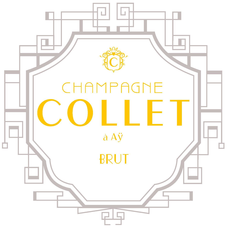Champagne Collet Champagne Brut Champagne Collet
$ 59,99 $ 30,00
CHAMPAGNE COLLET BRUT is the distinctive cuvée and identity of Maison Collet, harmoniously combining Champagne′s three main grape varieties: Chardonnay, Pinot Noir and Pinot Meunier.
BLEND:
25% to 30% Chardonnay creates elegance and finesse.
15% to 20% Pinot Noir adding depth and structure.
50% Pinot Meunier imparts freshness and rich fruit driven flavors.
25% of reserve wines are used depending on the year to preserve the distinctive style of CHAMPAGNE COLLET BRUT.
AGEING:
COLLET BRUT is aged for a minimum of three years in ideal conditions in our one hundred-year-old chalk cellars. We intentionally age our wines longer than the officially required period (minimum 15 months) so as to provide our customers with champagne that is at its optimum.
A dosage of 9.5 grams of sugar is added per liter.
TASTING NOTES:
Appearance: Light golden-amber color.
Nose: Toasted brioche aromas with fine citrus notes.
Palate: Powerful and full-bodied revealing great freshness and amazing length. Serve chilled at 7-8°C (44-46°F).
FOUNDED: 1921 by Raoul Collet
WINEMAKER: Sebastien Walasiak
CLIMATE: Continental (cold winters and warm summers) with year round rainfall
PROFILE: Since 1921, the house of Collet has been creating champagnes of character with a view to satisfy connoisseurs who are looking for authenticity, elegance and great finesse. Located in Aÿ, at the heart of the Champagne region, Collet′s vineyards are based mainly on Premier and Grand crus that reflect the diversity of the champagne regions terroirs.
VITICULTURE: Champagne’s primary distinguishing feature is that the vines are planted at the northernmost limits of their cold tolerance. The ideal vineyard sites are east to southeast facing, gently sloped, and are protected by thickly wooded hilltops allowing the grapes to ripen given the climatic challenges. Champagne Collet’s vineyards are in Premier and Grand Cru villages that reflect the diversity of Champagne’s terroirs. They source fruit from 850 growers spread over 160 different crus (there are a total of 320 crus in Champagne). However, winemaker Sebastien Walasiak uses no more than 10% of the overall vineyard yields to produce the best possible champagnes with year to year style consistency.
WINEMAKING: The grapes are gently pressed at stations in each vineyard within one hour of being hand harvested so that the clarity of the must is not compromised. Next, an indigenous, natural primary fermentation takes place at the winery. Walasiak blends the resulting base wines of the classic Champagne varieties from hundreds of individual vineyards and several vintages – vital, because blending is the ultimate art of Champagne and is the key to maintaining Champagne Collet’s incomparable house style. The cuvées are bottled with a bit of sugar and yeast for the second fermentation, or ‘prise de mousse.’ After disgorgement, the bottles are aged far beyond the minimum requirement in the winery’s 100-year-old chalk cellars resulting in softer wines needing less dosage. Some cuvées are matured in barrels from oaks grown in the appellation.
Quick Shipping and Professional Packaging
We offer a broad range of shipping options thanks to our long-running partnerships with UPS, FedEx and DHL. Our warehouse staff are educated to pack your items exactly as per the specifications that we supply. Your items will undergo a thorough inspection and be securely secured prior to being shipped. We ship to thousands of customers each day from multiple countries. This is a sign of our determination to become the largest online retailer worldwide. Both Europe as well as the USA have distribution and warehouse centers.
Please note that orders with more than one item will be given a processing time according to the specific item.
Prior to shipping, our team will perform an exhaustive inspection of the items you purchased. Today, the majority orders will be shipped within 48 hours. The delivery time is estimated to be between three and seven days.
Returns
The stock is constantly changing and cannot be fully controlled by us due to the involvement of several different parties, such as the factory and our warehouse. The actual stock can change at any moment. Please be aware it's possible your order may become unfulfilled when you have placed the order.
Our policy is valid for a period of 30 days. If it's been more 30 days since you purchased your item and we're unable to offer you a full refund or exchange.
You are able to return an item when it's unopened and is in the same condition when you first received it. It must also be in the original packaging.


































